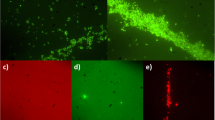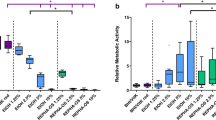Abstract
The origin of chronic periodontal disease is strongly related to the nature and physiology of the subgingival bacterial biofilm, of whichPorphyromonas gingivalis is a main protagonist. This study was conducted in vitro, to test the susceptibility of the W83 strain ofP gingivalis to several oral antiseptics, bearing in mind its mode of growth as biofilm. To this end, the investigators inoculated a brainheart infusion broth withStreptococcus gordonii, to whichPgingivaliswas added before perfusion for 7 d via a closed circuit containing a modified Robbins device. Then, various antiseptics were perfused through the circuit over 30 min, and their bactericidal effects were evaluated after culture by comparison of the mean proportion of bacteria killed. The average proportion ofP gingivalis W83 killed after 15 min of contact with antiseptics was 90.51% (±4.78) for chlorhexidine 0.2%, 89.87% (±6.58) for povidone-iodine 1%, and 98.6% (±0.86) for Listerine® (McNeil-PPC, Inc., Morris Plains, NJ). After 30 min of contact, survival ofP gingivalis was nil, irrespective of the antimicrobial agent used. Preliminary results show that antiseptic mouth rinses, when used in pure concentrations in the traditional way, are effective in killingP gingivalis W83 within a biofilm. Furthermore, in light of these experiments, it appears that the best results are obtained when Listerine is used; however, new trials should be conducted to confirm this observation.
Similar content being viewed by others
References
Nelson KE, Fleischmann RD, DeBoy RT, et al. Complete genome sequence of the oral pathogenic bacteriumPorphyromonas gingivalis strain W83.J Bacteriol. 2003;185:5591–5601.
Aas JA, Paster BJ, Stokes LN, Olsen I, Dewhirst FE. Defining the normal bacterial flora of the oral cavity.J Clin Microbiol. 2005;43:5721–5732.
Socransky SS, Haffajee AD. Periodontal microbial ecology.Periodontal 2000. 2005;38:135–187.
Hellstrom MK, Ramberg P, Krok L, Lindhe J. The effect of supragingival plaque control on the subgingival microflora in human periodontitis.J Clin Periodontol. 1996;23:934–940.
Kolenbrander PE, London J. Adhere today, here tomorrow: oral bacterial adherence.J Bacteriol. 1993;175:3247–3252.
Socransky SS, Haffajee AD. Microbial complexes in subgingival plaque.J Clin Periodontol. 1998; 25:134–144.
Lamont RJ, Jenkinson HF. Subgingival colonization byPorphyromonas gingivalis.Oral Microbiol Immunol. 2000;15:341–349.
Amano A, Kataoka K, Raj PA, Genco RJ, Shizukuishi S. Binding sites of salivary statherin forPorphyromonas gingivalis recombinant fimbrillin.Infect Immun. 1996;64:4249–4254.
Cook GS, Costerton JW, Lamont RJ. Biofilm formation byPorphyromonas gingivalis andStreptococcus gordonii.J Periodontal Res. 1998;33:323–327.
Lamont RJ, Jenkinson HF. Life below gum line: pathogenic mechanisms ofPorphyromonas gingivalis.Microbiol Mol Biol Rev. 1998;62:1244–1263.
Kolenbrander PE, Andersen RN, Blehert DS, Egland PG, Foster JS, Palmer RJ Jr. Communication among oral bacteria.Microbiol Mol Biol Rev. 2002;66:486–505.
Lamont RJ, Chan A, Belton CM, Izutsu KT, Vasel D, Weinberg A.Porphyromonas gingivalis invasion of gingival epithelial cells.Infect Immun. 1995;63:3878–3885.
Niederman R, Zhang J, Kashket S. Short-chain carboxylic-acid-stimulated, PMN-mediated gingival inflammation.Crit Rev Oral Biol Med. 1997;8:269–290.
Mayrand D, Grenier D. Biological activities of outer membrane vesicles.Can J Microbiol. 1989; 35:607–613.
Lindhe J, Nyman S. The effect of plaque control and surgical pocket elimination on the establishment and maintenance of periodontal health: a longitudinal study of periodontal therapy in cases of advanced disease.J Clin Periodontol. 1975;2:67–79.
Badersten A, Nilveus R, Egelberg J. Effect of nonsurgical periodontal therapy. I. Moderately advanced periodontitis.J Clin Periodontol. 1981;8:57–72.
Shiloah J, Hovious LA. The effect of subgingival irrigations in the treatment of periodontitis.J Periodontol. 1993;64:835–843.
Slots J. Selection of antimicrobial agents in periodontal therapy.J Periodontal Res. 2002;37:389–398.
Greenstein G. The role of supra- and subgingival irrigation in the treatment of periodontal diseases.J Periodontol. 2005;76:2015–2027.
Petersen FC, Scheie AA. Chemical plaque control: a comparison of oral health care products. In: Bussher HJ, Evans LV, eds.Oral Biofilms and Plaque Control. Amsterdam: Harwood Academy Publisher; 1998:277–293.
Stewart PS, Costerton JW. Antibiotic resistance of bacteria in biofilms.Lancet. 2001;358:135–138.
Scheie AA, Petersen FC. The biofilm concept: consequences for future prophylaxis of oral diseases?Crit Rev Oral Biol Med. 2004;15:4–12.
Larsen T, Fiehn NE. Development of a flow method for susceptibility testing of oral biofilmsin vitro.APMIS. 1995;103:339–344.
Larsen T. Susceptibility ofPorphyromonas gingivalis in biofilms to amoxicillin, doxycycline and metronidazole.Oral Microbiol Immunol. 2002;17:267–271.
Quirynen M, Teughels W, De Soete M, van Steenberghe D. Topical antiseptics and antibiotics in the initial therapy of chronic adult periodontitis: microbiological aspects.Periodontol 2000. 2002;28:72–90.
Slots J. Primer for antimicrobial periodontal therapy.J Periodontal Res. 2000;35:108–114.
Zambon JJ. Periodontal diseases: microbial factors.Ann Periodontol. 1996;1:879–925.
Cugini MA, Haffajee AD, Smith C, Kent RL Jr, Socransky SS. The effect of scaling and root planing on the clinical and microbiological parameters of periodontal diseases: 12-month results.J Clin Periodontol. 2000;27:30–36.
Costerton JW, Ellis B, Lam K, Johnson F, Khoury AE. Mechanism of electrical enhancement of efficacy of antibiotics in killing biofilm bacteria.Antimicrob Agents Chemother. 1994;38:2803–2809.
Kinniment SL, Wimpenny JW, Adams D, Marsh PD. The effect of chlorhexidine on defined, mixed culture oral biofilms grown in a novel model system.J Appl Bacteriol. 1996;81:120–125.
Noiri Y, Okami Y, Narimatsu M, Takahashi Y, Kawahara T, Ebisu S. Effects of chlorhexidine, minocycline, and metronidazole onPorphyromonas gingivalis strain 381 in biofilms.J Periodontol. 2003;74:1647–1651.
Pan PH, Finnegan MB, Sturdivant L, Barnett ML. Comparative antimicrobial activity of an essential oil and an amine fluoride/stannous fluoride mouthrinse in vitro.J Clin Periodontol. 1999;26:474–476.
Arweiler NB, Henning G, Reich E, Netuschil L. Effect of an amine-fluoride-triclosan mouthrinse on plaque regrowth and biofilm vitality.J Clin Periodontol. 2002;29:358–363.
Zaura-Arite E, van Marle J, ten Cate JM. Confocal microscopy study of undisturbed and chlorhexidine-treated dental biofilm.J Dent Res. 2001;80:1436–1440.
Ouhayoun JP. Penetrating the plaque biofilm: impact of essential oil mouthwash.J Clin Periodontol. 2003;30(suppl 5):10–12.
Pan P, Barnett ML, Coelho J, Brogdon C, Finnegan MB. Determination of the in situ bactericidal activity of an essential oil mouthrinse using a vital stain method.J Clin Periodontol. 2000;27: 256–261.
Tam A, Shemesh M, Wormser U, Sintov A, Steinberg D. Effect of different iodine formulations on the expression and activity ofStreptococcus mutans glucosyltransferase and fructosyltransferase in biofilm and planktonic environments.J Antimicrob Chemother. 2006;57:865–871.
Akiyama H, Yamasaki O, Kanzaki H, Tada J, Arata J. Effects of sucrose and silver onStaphylococcus aureus biofilms.J Antimicrob Chemother. 1998;42:629–634.
Author information
Authors and Affiliations
Corresponding author
Rights and permissions
About this article
Cite this article
Bercy, P., Lasserre, J. Susceptibility to various oral antiseptics ofPorphyromonas gingivalis W83 within a biofilm. Adv Therapy 24, 1181–1191 (2007). https://doi.org/10.1007/BF02877764
Issue Date:
DOI: https://doi.org/10.1007/BF02877764




